The best camping knives are effective tools that enhance your outdoor experience without having to make any sacrifices.
But, what makes some camping knives better than others? And, more importantly, what aspects should you consider when looking for an outdoor knife?
After countless backcountry adventures, speaking with outdoor specialists, and hours upon hours of research and testing, I’ve complied the following list of the 5 best camping knives.
Article Contents:
3 Important Aspects to Consider for a Camping Knife
Before heading out for my next backcountry adventure, I typically pack the camping essentials – a tent, sleeping bag, water filter, tarps, cooking equipment, and proper clothing.
But, no matter where I camp, I always pack and bring my trusty camping knife, specifically the Camillus BushCrafter. It’s served me well for the past 5 years, and no doubt well into the future securely holstered to my DIY utility belt.
However, when it comes down to which camping knife YOU should bring, it’s a trade-off between 3 key aspects. In my experience, it’s a balance between blade properties, handle properties, and knife type.
1. Blade Properties
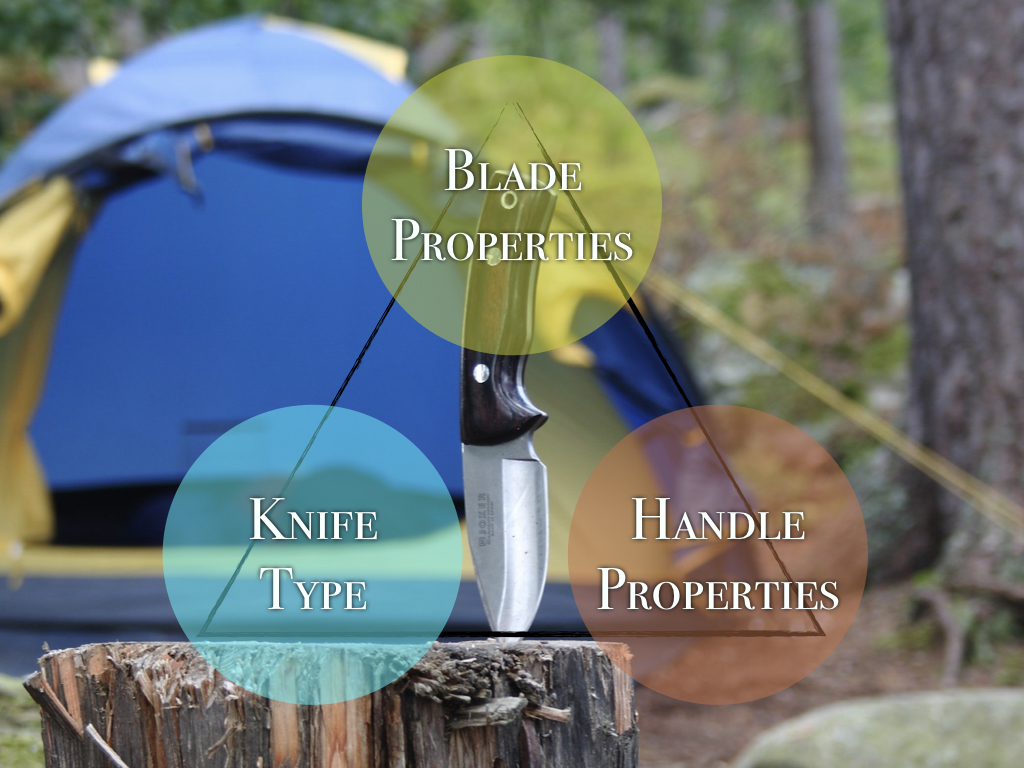
Blade Materials
The biggest influence on the performance of a camping knife is the blade material.
Camping knife blades are typically made of out carbon steel, stainless steel or titanium, all of which are high strength and light-weight.
But, without going into too much detail on every single option out there, generally:
- Stainless steel and titanium are corrosion resistant, making them better options for more care-free use
- Steel is usually more affordable than titanium
- Titanium knives are typically reserved for ocean use or ultra-light expeditions
- Carbon steel can hold a sharp edge longer than stainless steel, but is less corrosion resistant
A high-strength stainless steel knife is a good all-around material to select for camping.
Blade Coatings
Corrosion is a huge issue when it comes to metal tools and equipment. That’s because prolonged exposure to moisture or sea water can lead to excessive amount of rust which is detrimental to knife blades.
Corrosion can reduce the sharpness of the blade and decrease the strength of the material. Overtime, this can lead to a great risk of injury as well as potential failure (stress corrosion cracking) while in use.
As the name implies, stainless steel is corrosion resistant but carbon steel is susceptible to corrosion and must be maintained properly to prevent rust formation.
So, to enhance the corrosion resistance of certain materials, some manufacturers apply a coating to their knife blades to prevent corrosion of the base metal.
Grinds
The grind is the shape of the knife edge and dictates how well it can cut, retain its sharpness, and its overall durability.
Although there are many grinds for knives, typically camping knives have one of the following grinds:
- Hollow Grind – Very sharp but weak edge, difficult to sharpen
- Scandinavian Grind – Easy to sharpen, high strength
- Convex Grind – Maintains a stronger edge, difficult to sharpen
A Scandinavian grind is widely considered the best all around knife edge. It’s great for bushcraft and general camp use.
A hollow edge is great for processing animals. A convex edge is great for finer cutting tasks like whittling wood.
2. Handle Properties
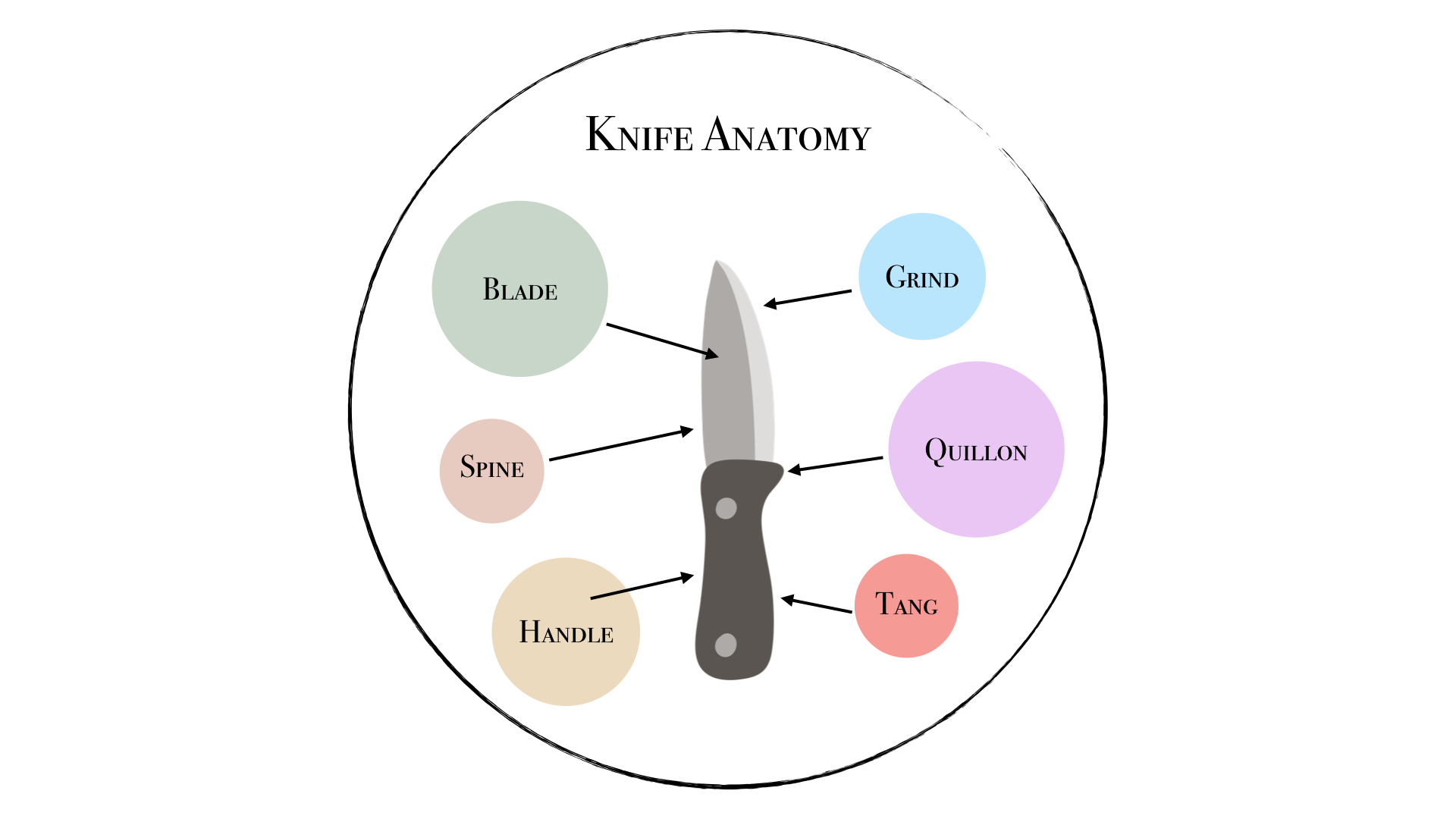
An often overlooked aspect, a knife handle is incredibly important to consider when selecting the right camping knife.
A high-quality, ergonomic handle will last a lifetime and can lead to less user fatigue.
Handle Materials
Knife handles traditionally have been made out of wood. But, nowadays, handles can be made of out durable plastic, rubber and even composite materials such as Kevlar and carbon fiber.
In high-end knives, handles can also be made from animal bone, horns or ivory.
The handle material can make up a large proportion of the weight of a knife, but in general:
- Wood and rubber handles are heavier than plastic and composite materials
Some knives are designed with removable/replaceable handles. This means if your knife handle is damaged, or you want to change the handle material, you can easily remove and replace it yourself.
Ergonomics
The overall shape and feel of the handle is very important. And, since everyone’s hands are different, the same knife that is comfortable for one person might feel terrible in the hand for you.
But, there are certain design qualities that make certain handles more ergonomic than others.
- Rounded corners put less pressure on your palms
- Finger groves provide you with a better grip
- A front and rear quillons prevents your hand from slipping off the handle
- If your palms tend to sweat or you’ll be using the knife in wet conditions, consider textured or knurled handles.
When testing a knife, holding it in different positions to see how well it suits your hands.
Ultimately you want something you won’t mind gripping for extended periods without causing too much strain or may result in blisters.
3. Knife Type – Fixed & Folding Blade
All knives can be classified as either fixed blade or folding blade. Both types have several advantages and disadvantages, which are detailed below.
Fixed Blade Knife
A fixed-blade knife consists of the blade metal running through the handle. In some knives, the metal extends through the entirety of the handle. This is known as “full tang”:
- The metal through the handle provides the back-bone for the handle, and results in a very strong and resilient design
Because the blade and handle are a single, solid piece, a fixed-blade knife is better suited for more rigorous tasks such as processing wood (i.e. batoning).
- There is no specific weak point such as a hinge where repeated use or damage could cause the knife to fail while in use
Fixed-blade knives require a sheath for carrying and transportation to shield their edge from damage.
Folding Blade Knife
A folding-blade knife has the ability to collapse or retract into the handle resulting in a more compact design.
- The blade pivots open and closed along a hinge and is usually locked into position by a lever mechanism
Some knives lock the blade in both the open and closed positions, which may dictate its ability for single-handed operation.
Since the blade and handle are attached by a hinge, folding blades are relegated to less impactful cutting tasks.
- Generally, the risk of the knife breaking or disengaging from the lever mechanism is higher so more care is needed when using folding knives
Folding blades do not need a sheath since they retract into their handle. This design aspect makes them great as an everyday carry (EDC) knife. They can be tossed into a back-pack or back pocket which out any concern.
Best Camping Knives [Top 5]
Best Campsite Preparation Knife
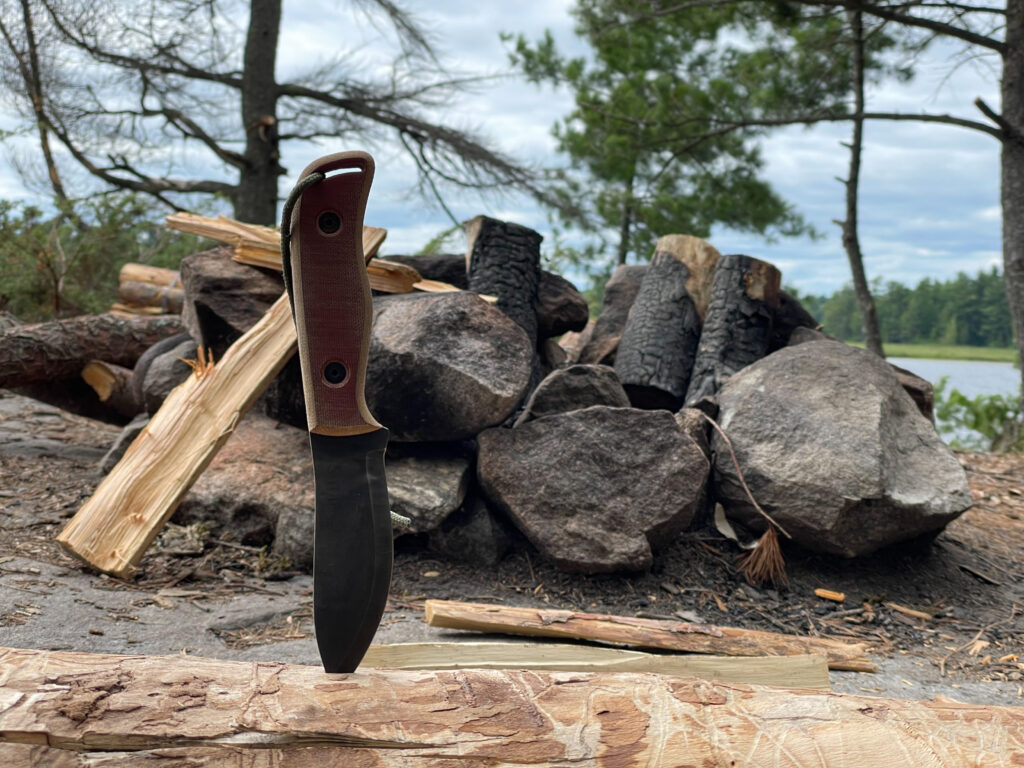
When prepping your campsite, you’ll be cutting rope, opening packaging, and modifying or repairing equipment.
A compact, utility style knife is best suited for this duty, whereas maintaining a razor sharp knife edge isn’t important.
The Benchmade Grizzly Ridge is an ultra-portable folding knife that’s super quick to deploy.
- The folding mechanism allows for single-handed use.
- The handle is textured and very graspable.
For anyone looking for a solid campsite knife, the Benchmade is a no-brainer.
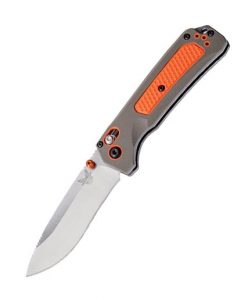
Benchmade Grizzly Ridge 15061
Type: Folding Blade
Length: 3.5″ blade, 7.8″ overall
Handle: Grivory / Versaflex
Sheath: Not Required, Built-in Belt Clip
Best Food Preparation Knife
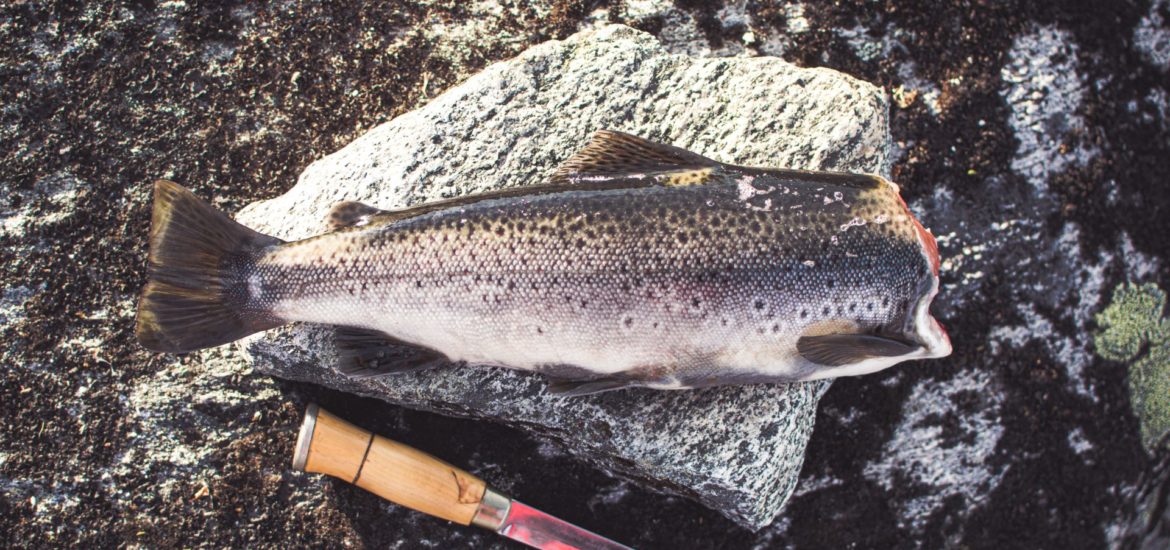
To prepare meals while camping, you may be slicing fruits, peeling vegetables and cutting meats.
A fine, sharp blade and moderately sized knife is great for these tasks.
The Roamer by Steel Will is widely considered one of the best meat carving and food prep camp knife you can get your hands on.
- The thin and light weight blade make it very nimble in-hand.
- Its ergonomic handle reduces user fatigue.
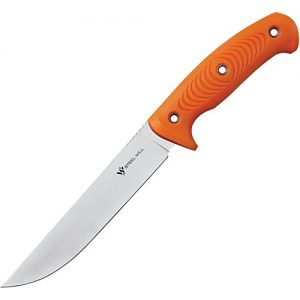
Steel Will R375-1OR Roamer
Type: Fixed Blade
Length: 6.4″ blade, 11.6″ overall
Handle: Plastic
Sheath: Plastic
Best Wood Processing Knife
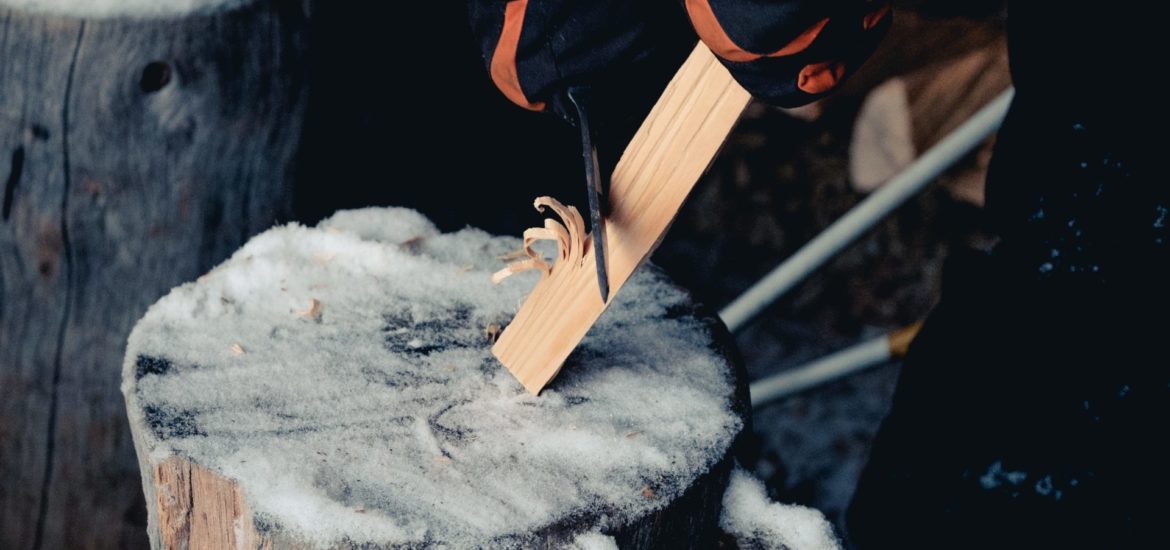
Most of the time while camping, you’ll need to prepare plenty of firewood to enjoy a long lasting fire. Chopping wood requires a thicker blade with a sharp, long lasting edge
Usually, fixed blade knives with a Scandinavian grind are better suited for the rigours of cutting logs or making feather sticks for fire.
Built to last, the SRK by Cold Steel is tailor-made to chop through an endless stream of logs and branches without hesitation.
- The thick, heavy duty blade is durable, and the overall blade dimensions and geometry makes processing even heavily knotted wood pieces a breeze
The SRK is also widely used by military and law enforcement personnel!

Cold Steel SRK
Type: Fixed Blade
Length: 6” blade, 12” overall
Handle: Rubber
Sheath: Plastic
Best Animal Processing Knife
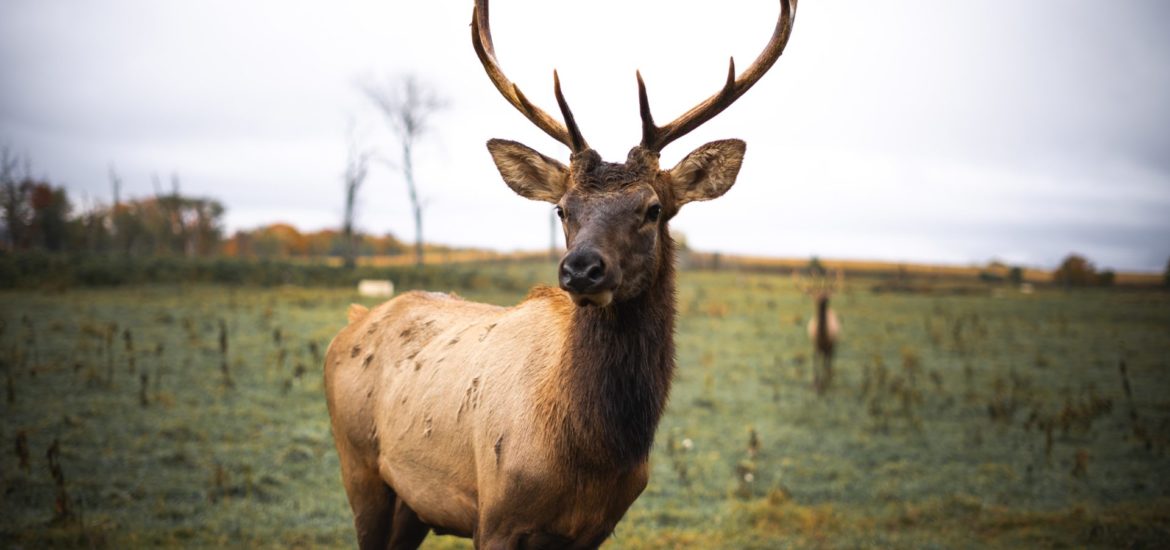
Butchering game in the backcountry can become a very difficult task especially with the wrong knife in hand.
Gutting, filleting and skinning animals requires a knife that can be easily manipulated with a sharp edge.
A mid-sized knife with a convex blade would be perfectly suited to process game.
Cleaning a fixed blade knife would also better compared to a folding blade knife for this kind of work.
With that said, and once the hunt is over, the Benchmade Hidden Canyon Hunter knife can make quick work of both small and large game. It’s a hunter’s best friend!
- Sharp-edged, mid-length blade allows for accurate cuts with minimal effort
- Skinning, filleting or carving is so much easier with this knife in-hand
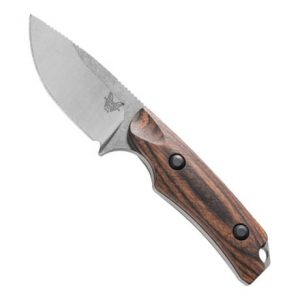
Benchmade Hidden Canyon Hunter
Type: Fixed Blade
Length: 2.7″ blade, 6.3″ overall
Handle: Wood
Sheath: Leather
Best Personal Protection Knife
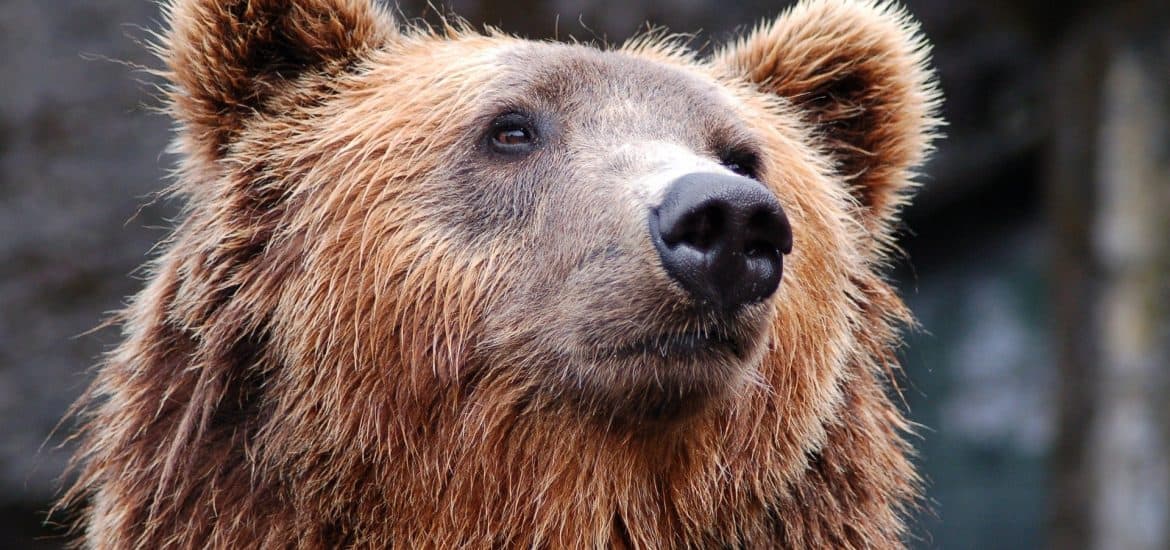
Knowing that you have a knife strapped to your belt or tucked away in a pocket can give you peace of mind, especially in the backcountry.
You never know when a curious or aggressive animal will make a visit. Although you should do everything to prevent an unwanted visit, as a last resort, you can quickly pull out your knife to defend yourself in case of an attack.
A mid to long length knife used effectively has a lot of stopping power.
Folding knifes are great since they can always be kept in a pocket and ready to be deployed, BUT a fixed bladed knife cuts down on your readiness time.
And, sometimes, those few seconds are critical to protecting and preserving yourself and others.
The Ka-Bar USMC is a great, no nonsense knife to carry in bear and cougar country. It can be pulled out quickly if an attack is imminent, and used effectively to help fight off a predatory animal.
In a life or death situation, you’ll want the USMC firmly in your hands!
- The extended length of the blade and ergonomic handle gives it a lot of predator stopping power
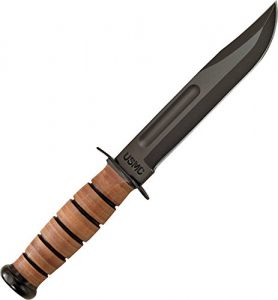
Ka-Bar USMC
Type: Fixed Blade
Length: 7.0″ blade, 11.9″ overall
Handle: Leather
Sheath: Leather
This article contains affiliate links, which help support this blog at no cost to you!

thank you for the article